Pushups are a powerful exercise but they may not be the right choice for you. Luckily, there are plenty of alternatives that could be better for your situation.
Some of the main benefits of pushups come from their ability to grow and strengthen your chest, core, and arm muscles and that they are a no-equipment exercise you can do at home.
You may not like pushups, find them uncomfortable on your wrists, elbows, or shoulders, or you may want a good alternative for different reasons.
In any case, at least some of the exercises below will likely be able to help you.
Keep in mind that implementing a suboptimal technique can be a reason for pushups being uncomfortable on body parts like your shoulders.
If this is the case, make sure you keep your upper arms at angles of 45 degrees or less to your sides during pushups.
1. Incline pushups
Before you throw out any type of pushup movement you need to know that different variations can challenge different muscles and body parts more and less.
One example where you put less pressure on your body and target your lower chest muscles more is the incline pushup.
To do one you need a stable elevated place to put your hands. After that, take the following steps to do an incline pushup:
- Stand in front of the stable elevation and put your hands on it at about shoulder-width apart. Keep your arms just a bit less than stretched.
- Step back with your feet until your body is in a straight line from your heels to the top of your head. Keep your shoulders above your hands.
- Slowly lower your body as far as comfortable by folding your arms at your elbows. Keep your upper arms at angles of 45 degrees or less to your side. From above, your body should look like an arrow, not a T-shape.
- Push yourself up in a controlled motion until you are back in the position of step 2.
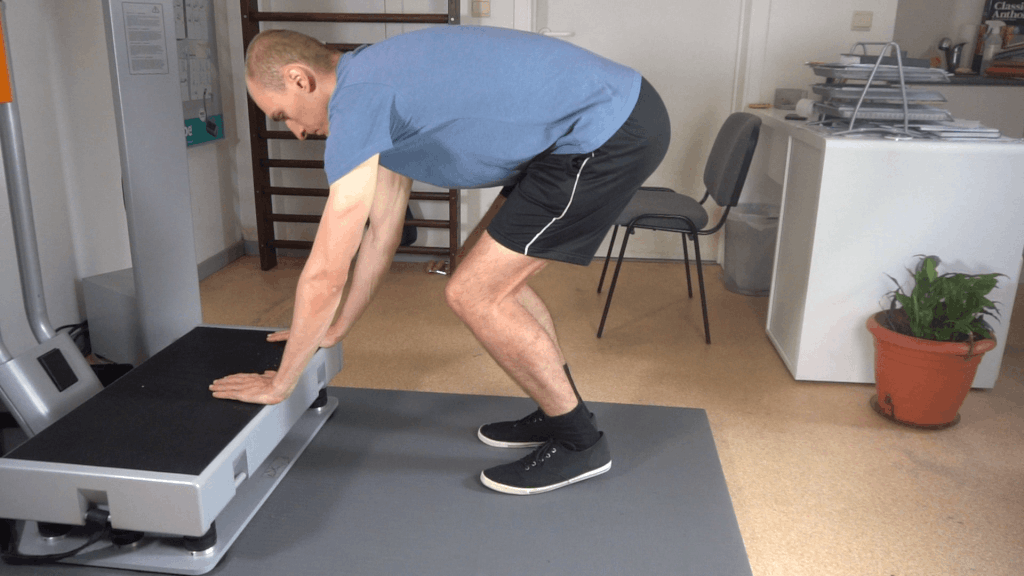
One of the first reasons some people may prefer the incline version is that it is easier to do. Less of your body weight rests on your arms, wrists, and shoulders.
The more incline you go, the higher you place your hands, the easier the pushups become. You can even do wall pushups which are the classic bodyweight exercise done against a wall.
Incline pushups are a great option if you do not yet have the ability to do a full pushup or if your wrists are not strong enough (yet) to carry your full body weight.
2. High plank to low plank
Take the following steps to do a high plank to low plank:
- Sit on your hands and knees with your hands about shoulder-width apart. Keep your arms slightly less than stretched.
- Walk back with your feet until your body is in a straight line from your head to your heels. Keep your shoulders above your hands.
- Fold one arm and place the elbow and forearm of this side on the ground.
- Do the same with the other arm. You are now in a low plank position.
- Stretch one arm and lean on your hand on this side.
- Do the same with the other arm. You are now in a high plank position.
- Repeat starting from step 3. Alternate between which arm goes first to keep your muscle distribution balanced.
Because you have to spend extra time switching positions, the high plank to low plank works your core muscles more and chest, tricep, and front deltoid shoulders less than a regular pushup.
Besides that, you may simply find this pushup alternative a fun way to switch up your workouts.
3. Resistance band chest press
For the resistance band chest press, you need a resistance band or two and a place to anchor the resistance bands at about chest height.
Once you have the required gear, take the following steps to do a resistance band chest press:
- Loop the resistance band behind/through the anchor, hold one end of the band in each hand, and stand in front of the anchor with your back toward it. Keep your hands beside your chest and keep your upper arms at 45-degree angles to your sides.
- Step forward until you feel some tension in your chest muscles. Put one foot forward and one foot back for stability.
- Push your hands forward as far as your resistance bands allow or until your arms are slightly less than stretched.
- Return your hands to the position in step 2 in a controlled motion.

Resistance band chest presses are basically the same movement as pushups but you are standing up straight and using resistance bands.
This typically leads to slightly less core engagement with similar amounts of chest, tricep, and front deltoid engagement.
Another potential of choosing this substitute is that they could be more comfortable on your wrists than pushups with a few adaptations.
Instead of holding the resistance bands, you can loop them somewhere around your arm. Potentially with something like a T-shirt wrapped around your arm under it for comfort and safety.
4. Bench press
When it comes to gym chest exercises, the bench press is the number one choice by far. To do this exercise, you need a sturdy weight bench and a weight to lift.
Most people prefer using a barbell but you can also use other options like dumbbells, kettlebells, a workout sandbag, etc.
Take the following steps to do a barbell bench press:
- Rack the barbell at a height where you can complete the next steps. Load it with the desired number of weight plates and put the bench below it.
- Lie down on the weight bench with your shoulder blades pulled back and down. Put your hands on the barbell at about shoulder width. At this point, your arms should be somewhat folded.
- Push up the barbell and move it forward until it is positioned above your chest.
- Slowly lower the barbell to your chest as far as comfortable.
- Push the barbell back into the position of step 3 in a controlled motion.
The bench press is basically an upside-down pushup. Instead of pushing your body up against gravity you do the same movement but push the barbell.
This can be helpful because it allows you to focus more on working your chest, tricep, and front deltoid muscles without having to worry about fatiguing your core muscles.
It is also easier to add a lot of weight to a bench press compared to adding the same weight in a weighted pushup.
One downside of this pushup alternative is that there are a lot of equipment requirements. You will either need to invest in home fitness equipment or a gym subscription.
5. Chair or bench dips
As the name implies, this next alternative to pushups requires you to have a chair, bench, or a sturdy surface at about knee height.
Take the following steps to do a chair dip:
- Find 2 stable chairs and put them right next to each other.
- Place your hands at more or less shoulder-width apart on the surface with stretched arms. Your feet are flat on the ground before the chairs. Pull your shoulder blades back and down.
- Slowly bend your arms until your elbows are at 90-degree angles. The rest of your body should barely not touch the chairs. Try to put as much weight on your arms as possible, your legs should be used as balance, not to move you.
- Raise yourself back up into the position of step 2 by stretching your arms in a controlled motion.
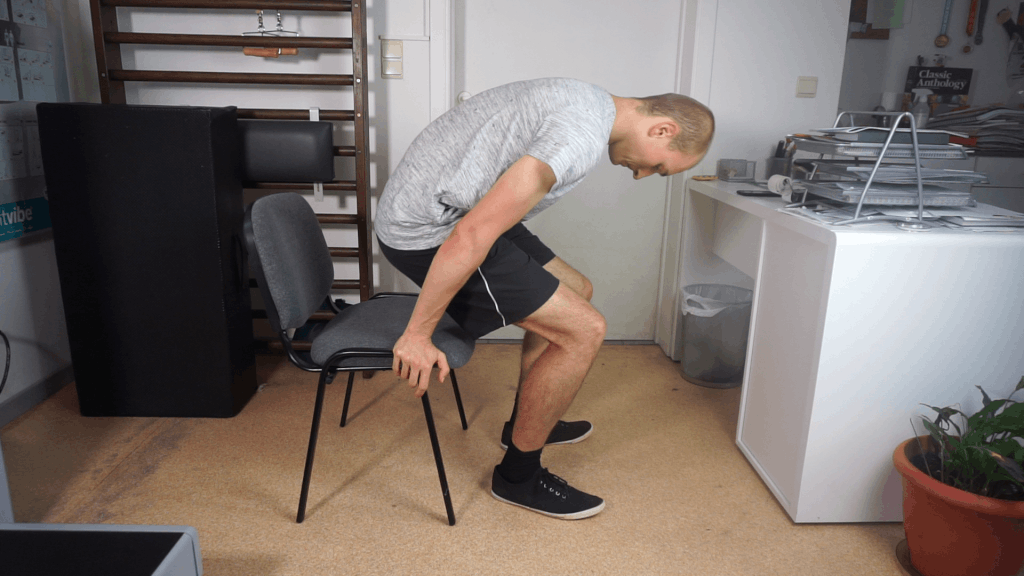
Regular parallel dip bars are typically better but the chair version tends to be more at-home friendly.
Chair dips are more of a tricep isolation exercise. This different focus could be an upside or downside depending on why you are looking for a pushup alternative.
6. Crunches
To do this next exercise you preferably have a yoga mat or a similar soft surface. Once you have that, take the following steps to do a crunch:
- Lie down on your back with your feet flat on the ground in front of your butt. Put your arms against your chest.
- Slowly raise your shoulders as far as comfortable while keeping your lower back on the ground.
- Lower your shoulders back to the ground in a controlled motion.
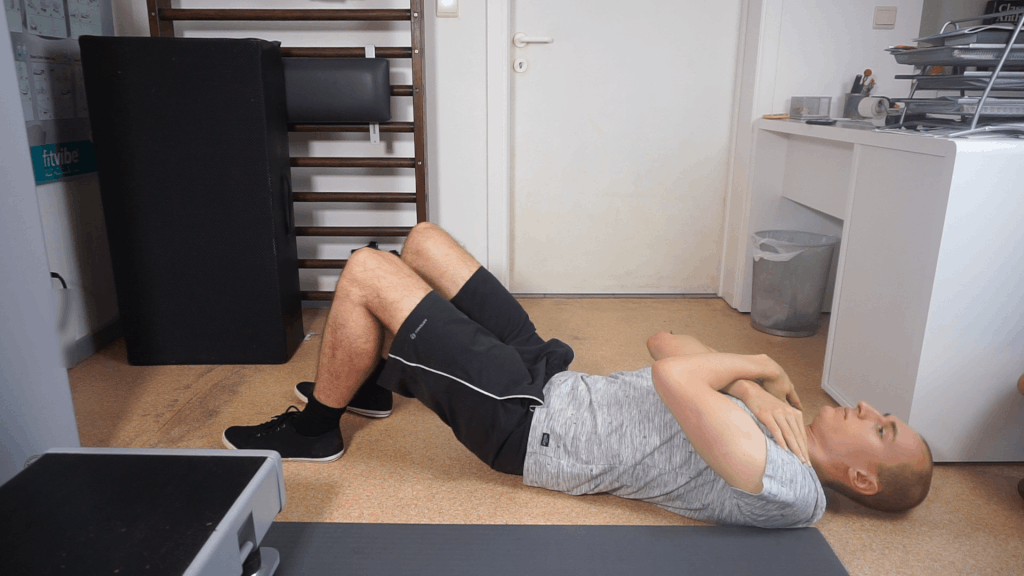
Crunches are definitely an unusual alternative in the sense that they have a completely different focus than pushups. At the same time, you can say that pushups work core muscles like your abs and obliques to some extent.
To focus more on this part of the exercise, more specifically growing and strengthening your abs, you can consider doing more crunches.
You can also implement both exercises in your at-home bodyweight resistance training workout schedule.
7. Lying chest fly
To do a lying chest you again need a weight bench and some weights. This time a barbell is not an option since you need one-handed resistance.
Once you have the required gear, take the following steps to do a lying chest fly:
- Sit on the end of a weight bench with a dumbbell in each hand. Let the dumbbells rest on your thighs for now.
- Kick the dumbbells back and up with your legs and lie down on the weight bench at the same time. Pull your shoulder blades back and down. Keep your arms slightly less than stretched and pointing up. Your hand palms should point to each other and the dumbbells should touch each other.
- Move the dumbbells sideways and downward as far as comfortable in a controlled motion. Keep your arms slightly less than stretched in this movement.
- Slowly return the dumbbells back to the position of step 2 by moving them up and to the center.
The lying chest fly is a chest muscle isolation exercise. Besides the different muscle engagement, the chest fly also tends to be more comfortable on your wrists and elbows.
If discomfort in these areas stops you from working your chest muscles with pushups, this exercise can be a great alternative.
8. Bird dog exercise
Take the following steps to do a bird dog:
- Sit on your hands and knees with your arms slightly less than stretched.
- Move one foot back until the leg is slightly less than stretched and in one line with your upper body. At the same time, you want to move the hand of the opposite side forward until it is in one line with your body. The main goal of the exercise is to keep your hips in the same position in relation to your spine throughout this movement.
- Lower the leg and arm again so that you are back in starting position.
- Repeat the movement from step 2 with your other leg and your other arm.
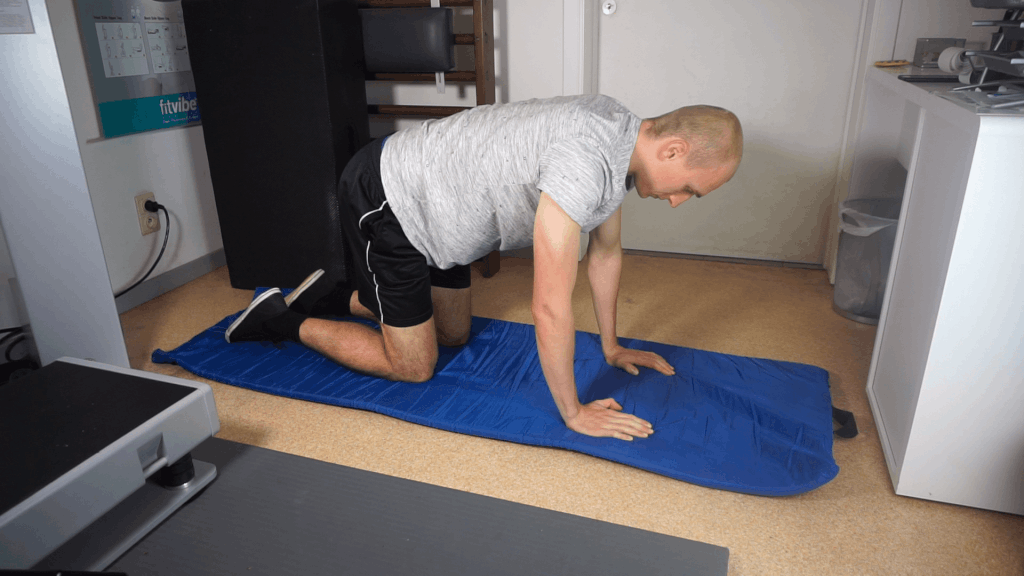
Some people are looking for a pushup alternative because they are not able to keep their spine straight throughout the movement (yet).
If that is the case for you, the bird dog exercise can help somewhat with improving endurance in your core muscles. Make sure you really engage these muscles throughout the movement to see results.
9. Decline pushup

Similar to the first exercise on this list, it is also possible to modify pushups by doing them in a decline position. This is where your feet are the body part that is elevated.
To get into a decline pushup position you walk up to the elevated surface you will use with your back towards the elevated object. The next thing you do is squat or bend down to get your hands on the surface.
After that, you place your feet on the elevated surface. Lastly, you move forward with your hand while keeping your feet in place until you can get into the right pushup posture.
The decline pushup is a great alternative to regular pushups for reasons opposite from the incline pushup.
As you get more experienced, you may find the high amounts of repetitions required to see muscle growth results with regular pushups annoying.
Instead of doing weighted pushups, you can also start doing decline pushups at this point. Because more of your body weight rests on your chest, tricep, and front deltoid muscles, you will need to do fewer repetitions.
Decline pushups also focus more on your upper chest muscles and front deltoid muscles if you go very decline. This may align more with your aesthetic and performance training goals.
10. Planks
Planks are another popular core muscle exercise and the starting stance for the pushup exercise. Take the following steps to do a high plank:
- Sit on your forearms and knees with your hands about shoulder-width apart.
- Walk back with your feet until your body is in a straight line from your heels to the top of your head. Keep your shoulders above your elbows.
- Hold this position for a certain amount of time.
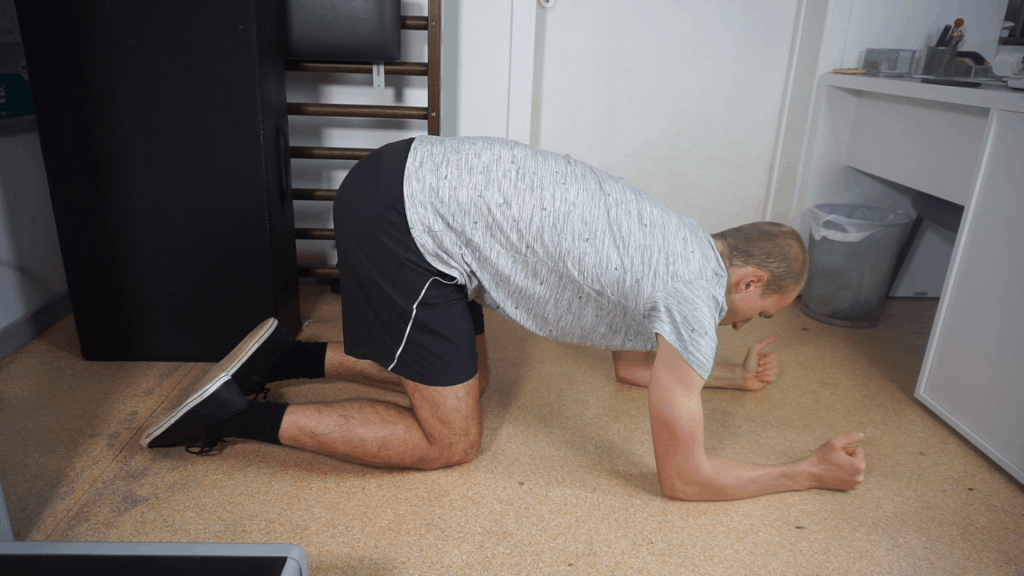
Planks are another more unusual pushup alternative in the sense that they focus on improving endurance in your core muscles. A potential benefit is that they do this without pressuring your wrists a lot.
At the same time, planks are definitely not a complete replacement for pushups. You basically don’t get any chest, tricep, and front deltoid engagement.
